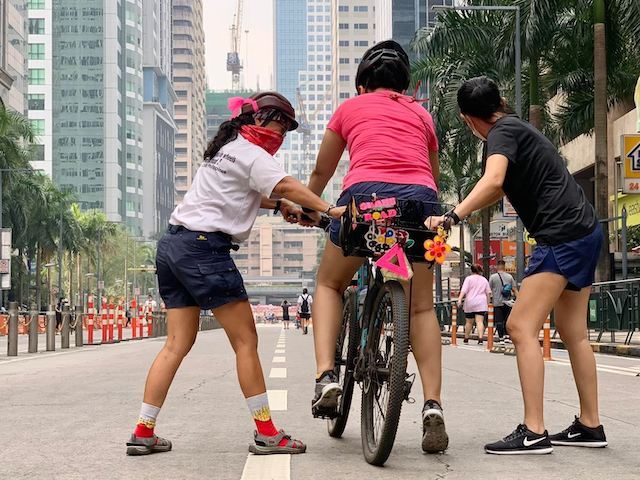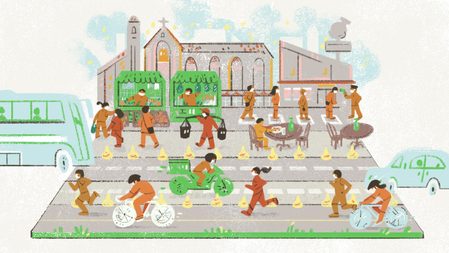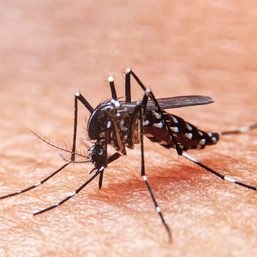SUMMARY
This is AI generated summarization, which may have errors. For context, always refer to the full article.

MANILA, Philippines – How would the quality of life in your barangay or city improve if there was a public open space 10 to 15 minutes away, by foot?
Numerous studies and papers have shown the benefits of parks to people. Public parks are known to improve mental health, reduce air pollution, enliven local economies, and more.
In the Philippines, many sectors and groups have long been calling for more public open spaces, especially in cities where there is a dearth of them, amid rapid and often uncontrolled urbanization.
Policy-wise, progress was achieved in mid-2023 with the signing of a joint administrative order by no less than six department secretaries and two agency heads.
Robert Siy Jr., co-convenor of the Move As One Coalition, pointed to this new government directive as a possible starting point for anyone who wants to engage with government in creating parks in their own communities.
The Move As One Coalition, a network of mobility and active transport activist groups, had actively lobbied for this order, said Siy in an interview on Rappler’s “Be The Good” show aired on December 15.

The Joint Administrative Order No. 2023-0001 was signed by the secretaries of health, tourism, interior and local government, housing, environment, and public works departments; and the heads of the National Commission for the Culture and Arts and the Philippine Commission on Women.
Dated August 2023, it’s entitled, “Guidelines on the Creation, Use, and Management of Parks and Public Open Spaces for the Promotion of Physical and Mental Health and Social Well-being.”
Calling it a “milestone document,” Siy, a public transport expert, said, “We can use this as civil society to lobby and encourage our local officials to actually take action. Because there’s a policy basis now. This is the national government’s order already. This is their aspiration.”
Siy thinks there should be at least one public open space in every barangay, and that this government directive can make that into reality.
What are highlights of the multi-agency order? It states that:
- The role of both national and local government is to ensure the “availability and accessibility of healthy and safe public open spaces.”
- National resources “shall be mobilized” for the creation and use of public open spaces.
- Local government resources are to be mobilized and local governments must include the creation and improvement of public open spaces in their local development plans.
- Implementation of the policy promoting parks will be monitored by the Department of Health as part of its Healthy Communities Program.
- The Department of Public Works and Highways should create a special initiative to build public open spaces “in selected national roads and bridges,” and coordinate with local governments on this.
The roles of all the signing government agencies are spelled out in the order, as well as the guidelines and standards for parks and open spaces. Read the entire document here.
How to get started
Siy was asked during the interview for his suggestions on how concerned citizens can, on their own, start an initiative to create a public open space in their area.
We paraphrase his tips here.
1. Get a group of concerned and like-minded community members together. Approach the barangay captain and discuss the possibility of creating a public open space. Bring a copy of the joint administrative order to cite as basis for why the local government must support your initiative. It’s important to involve as many stakeholders as possible – from local bicycle groups, business chambers, schools, and more.
2. With the barangay officials and other members of the community, select a place for the public open space. The proposed public park doesn’t have to be large. There are benefits to pocket parks too. With the lack of available land in many cities, you could propose the creation of a peoples’ street. The joint administrative order explicitly supports the establishment of people’s streets. It has its own definition in the order.
People’s streets are streets, roads, parking lots, or bridges that are “prioritized for use by pedestrians, bicycles, and light mobility devices, closed for motor vehicular through-traffic, and are designated only for physical activity, leisure, and recreational use by community members exclusively or on a specified schedule.”
For a people’s street, choose a street that, if closed off to cars, will not create traffic jams in the area. Siy suggests choosing a street in an area where the streets are in a grid system so that, when that street is closed, those parallel to it can be used as alternative routes. In Pasig City, this is implemented in Emerald Avenue. In Makati, Ayala Avenue was chosen. Siy said the Tomas Morato area, with the “Scouts” streets, is a good place to create a people’s street because of its grid arrangement.
3. Decide when and how long the car-free period will be for that street. You can start slow, blocking off only a few hours during a day of the week known to have the least car traffic – like Sunday mornings. Depending on how the community reacts to the initiative, decide whether to scale it down or up. Should it stay a people’s street only on certain holidays? Should this be extended to months because it has been beneficial to tourism and the local economy?
4. Decide what activities to hold in the street or park. They can be exercises like Zumba, or games like a treasure hunt for children. The community can hold bazaars or food fairs. Activities can also help market the initiative to the community, get their buy-in, and improve social cohesion. This could be your chance to meet your neighbors or exchange more than a greeting.
If done right and with consistency, the people’s street or park initiative will “take a life of its own,” said Siy.
Online sentiment about car-free streets or people’s streets are mostly positive, said Ivy Pedida, a Rappler Digital Communications Specialist who did an online scan about conversations surrounding these initiatives.
She said lots of people go on social media to express their satisfaction and delight at people’s streets, like those in Pasig City. Parents, in particular, post about how they feel their children are so much safer when biking or jogging in these car-free streets.
“They are very happy. If there is any criticism, what we can see is how this can be implemented longer. That’s what people really want,” said Pedida. – Rappler.com
Add a comment
How does this make you feel?






There are no comments yet. Add your comment to start the conversation.